

The Dragon is a creature set apart from any other not beacause of
his appearance, but because of the incredibly high intelligence level.
One reason why the dragon attains an intelligence so much higher
than that of man is most likely due to that fact that dragons live
so much longer than man. It is wisdom gained over hundreds of years
of experience that makes the dragon our superior. Young dragons in fact
are much less intelligent than young humans. This could be because
human children are raised and taught by their parents for many years.
Young male dragons are left to hatch and fend for themselves. They
rely purely on instinct for many years. Their level of intelligence
at this time is no higher than a very cunning predator. The female
dragons who are much rarer and very highly regarded are taken to
the dragon court to be raised with the other young females where they
recieve teaching of dragon knowledge.
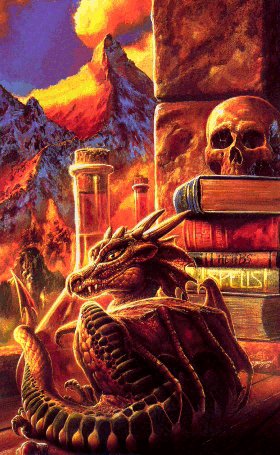 The adult dragon is astute and extremely powerful. His cunning helps
him to elude human traps and evade any attempt to capture or sometimes
even merely to see the dragon. The dragon is also very proud. As well
he should be, being well versed in magic and earth sciences. The
dragons knowledge and use of magic is yet another piece of evidence
proving his wisdom and intellectual ability. It is well known that
magic takes an enormous amount of concentration and conditioning.
Dragons have been know to magically hold human forms for many days
without rest or returning to their original form. That is a task
not easy to achieve without incredible concentration. In addition
to taking human forms, dragons are also very versed in human language.
Although the dragons' prefered language is latin, dragons are known
to speak any toungue from within the region in which they live. A dragon also
knows the power associated with names. Something which he keeps a closely
guarded secret so as not to be used against him. A dragon goes only
by assumed names so his cannot be used against him. A dragon's name
is given to him by his father and changes throughout his lifetime
as he encounters different events and as he matures.
The adult dragon is astute and extremely powerful. His cunning helps
him to elude human traps and evade any attempt to capture or sometimes
even merely to see the dragon. The dragon is also very proud. As well
he should be, being well versed in magic and earth sciences. The
dragons knowledge and use of magic is yet another piece of evidence
proving his wisdom and intellectual ability. It is well known that
magic takes an enormous amount of concentration and conditioning.
Dragons have been know to magically hold human forms for many days
without rest or returning to their original form. That is a task
not easy to achieve without incredible concentration. In addition
to taking human forms, dragons are also very versed in human language.
Although the dragons' prefered language is latin, dragons are known
to speak any toungue from within the region in which they live. A dragon also
knows the power associated with names. Something which he keeps a closely
guarded secret so as not to be used against him. A dragon goes only
by assumed names so his cannot be used against him. A dragon's name
is given to him by his father and changes throughout his lifetime
as he encounters different events and as he matures.
The wisdom of an elder dragon is matched by no other creature
known on this earth. Much of a dragons power and prestige is
due to its great wisdom. Thanks to his wisdom, the dragon has been
both revered and feared by humans throughout the ages. Whether or not
dragons still exist today remains a mystery. They have the ability
to walk among us, or to hide and never be found. Only a priveledged
few might have the fortune to meet one.

I'm sure we are all familiar with the basic appearance of the dragon.
It's a big scary winged creature with razor sharp claws, poison
carrying teeth and evil dark red eyes right? Wrong! This is the
image burned in our minds. It is a picture of a creature rarley seen
by scared peasants and described as horribly as possible by jealous
wizards of old. True, most dragons have wings and claws. But so do
most birds. And as for the poison teeth and dark red eyes...I think
I saw that in a movie some where. Real dragons are creatures of
beauty, both inside and out.
 The Dragon (Drago drago) can be classified as a reptile.
However, it is a homoiothermic creature. Meaning it is a warm-blooded
creature, internally controlling his body temperature. This, of course,
allows him to live in any environment he chooses. As mentioned above,
most dragons do have wings and hollow bones for lightness. But some
of the more ancient dragons, usually found in the eastern part of the
world (China, Asia), have stubby legs and no wings. In fact the only
thing separating these dragons from large predatory lizards are the
predominant crests and bird-like claws they posses. All dragons are
covered with armor-like scales that have a trnslucent horny surface.
This gives the dragons the irridescent hue to their bodies. The Earth
dragon does not have scales on his neck or belly and many times
covers the exposed area with jewels for protection (and vanity some
might say). The skeleton of the dragon is very resemblant of that of
a common horse. The main differences appear in the skull, which often
has horns and sharp teeth, the tail and claws rather than hooves, of
course, and in the shoulder blade. A dragon's shoulder blade is highly
developed to accomodate for both the front arm or leg and the wing
structure. It is also relatively large compared to other animals
because it must support the large muscle mass for the wings.
The Dragon (Drago drago) can be classified as a reptile.
However, it is a homoiothermic creature. Meaning it is a warm-blooded
creature, internally controlling his body temperature. This, of course,
allows him to live in any environment he chooses. As mentioned above,
most dragons do have wings and hollow bones for lightness. But some
of the more ancient dragons, usually found in the eastern part of the
world (China, Asia), have stubby legs and no wings. In fact the only
thing separating these dragons from large predatory lizards are the
predominant crests and bird-like claws they posses. All dragons are
covered with armor-like scales that have a trnslucent horny surface.
This gives the dragons the irridescent hue to their bodies. The Earth
dragon does not have scales on his neck or belly and many times
covers the exposed area with jewels for protection (and vanity some
might say). The skeleton of the dragon is very resemblant of that of
a common horse. The main differences appear in the skull, which often
has horns and sharp teeth, the tail and claws rather than hooves, of
course, and in the shoulder blade. A dragon's shoulder blade is highly
developed to accomodate for both the front arm or leg and the wing
structure. It is also relatively large compared to other animals
because it must support the large muscle mass for the wings.
As mentioned before, not all dragons are of the stereotypical winged
variety. Many variations do occur as the dragons stay in a particular
environment for many generations. Some water dragons for instance,
do not have wings, instead they may have large winglike fins or nothing
at all and appear as a crested serpent. These "Sea Serpents" were
very common in the days of the vikings. The well known viking ships
which sported the dragon shaped masthead were carved in this manner
in an attempt to scare off the sea serpents. This very rarely worked
because dragons are much too intelligent to fall to such simple trickery.
But it made the vikings feel better! Other strange variations of dragons
have been spotted, such as the multi-headed Hydra. This variation
is believed to be a result of inbreeding defects rather than evolution.

A dragons coloring is something like a human fingerprint. Many dragons
have the same coloring but each dragon has its own mixture and
 pattern of different hues of that color. It would be impossible to list
all of the different hues and gradiations of color that dragons posses.
But all these colors can generally be placed into three broad
color groupings: the Blues, the Reds, and the Greens. The Blue Dragons
can range in color anywhere from dark blue to silver and mother of
pearl. The Red Dragons can be anything from copper to bright vivid
red, such as the dragon at right, to dark reddish-black. Greens,
which seem to be the most common (probably because they generally
live in the same environment as humans and are seen more), vary in
color from any shade of green to yellow and includes dark brown and
burnished gold. These three principle groups are not usually mixed,
however, as mentioned before, a dragons coloring will generally
vary with many different hues from one of the main catagories.
pattern of different hues of that color. It would be impossible to list
all of the different hues and gradiations of color that dragons posses.
But all these colors can generally be placed into three broad
color groupings: the Blues, the Reds, and the Greens. The Blue Dragons
can range in color anywhere from dark blue to silver and mother of
pearl. The Red Dragons can be anything from copper to bright vivid
red, such as the dragon at right, to dark reddish-black. Greens,
which seem to be the most common (probably because they generally
live in the same environment as humans and are seen more), vary in
color from any shade of green to yellow and includes dark brown and
burnished gold. These three principle groups are not usually mixed,
however, as mentioned before, a dragons coloring will generally
vary with many different hues from one of the main catagories.
Most dragons' scales also cary a metallic luster that makes them
shimmer in the sunlight. This is possibly another way of hiding.
By using this reflective luster to their advantage, they can reflect
the light waves from their surroundings and blend in much like a
lizard changes colors. If a dragon appears pale or his scales are
slightly opaque in color, this is a sure sign of poor health. Many
dragons are known in assumed name by their colors such as
Ancalagon the Black, Temeliay the Gold, or Canth the Brown.

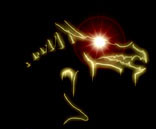 Dragons are very well versed in magic. But only in the natural magics.
Earth magic, Plant magic, and Water magic. Dragons do not devel in
black magic because they live in harmony with nature. Black magic
steals energy and life from nature to do its bidding. Of course, as
in any species, there are a disgruntled few who do practice Black
magic. But these live as outcasts never to recieve any help, or
recognition, and constantly living in fear of being killed by all
of the dragon clan.
Dragons are very well versed in magic. But only in the natural magics.
Earth magic, Plant magic, and Water magic. Dragons do not devel in
black magic because they live in harmony with nature. Black magic
steals energy and life from nature to do its bidding. Of course, as
in any species, there are a disgruntled few who do practice Black
magic. But these live as outcasts never to recieve any help, or
recognition, and constantly living in fear of being killed by all
of the dragon clan.
The dragon using natural magics knows how and to what extent he
can manipulate nature for his own purposes without disturbing the
delicate ecological balance. He can invoke the power of the elements
and create illusions including those which he may use for disguises.
A dragon can appear as part of the landscape or even as a human or
any other animal. Some of the more practiced, elder dragons can
hold a disguise for several days without falter. There are many human
legends of humans transformed into dragons. This is most likely
a case of a young dragon in disguise who accidentally lost concentration
or could just not hold the guise any longer without rest.
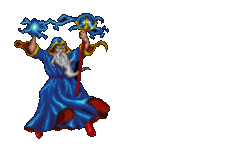 These magnificent dragon wizards hold great contempt for the clumsy
human wizards who often alter and corrupt the life forces of nature,
These magnificent dragon wizards hold great contempt for the clumsy
human wizards who often alter and corrupt the life forces of nature,
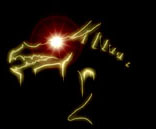 with no respect or thought of the consequences. This to the dragons
is practically black magic. The only reason the dragons let these wizards
live to practice magic in this way is because they know the wizards
do not know any better. The contempt is mutaul however, because
the wizards are jealous of the dragons great power and mastery of
magic. This is most of the cause of the dragons bad reputation. For
ages, medieval necromancers and preists who were jealous of their
superiors taught the common folk that dragons were the incarnation
of evil and the devil.
with no respect or thought of the consequences. This to the dragons
is practically black magic. The only reason the dragons let these wizards
live to practice magic in this way is because they know the wizards
do not know any better. The contempt is mutaul however, because
the wizards are jealous of the dragons great power and mastery of
magic. This is most of the cause of the dragons bad reputation. For
ages, medieval necromancers and preists who were jealous of their
superiors taught the common folk that dragons were the incarnation
of evil and the devil.

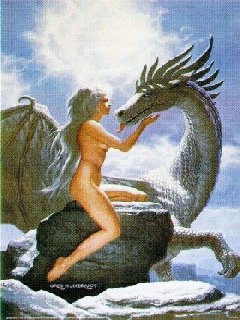 Dragons are deep lovers of all things beautiful. Art, poetry, jewelry
amd jewels, and of course they have their favourites. Favourites
are the women which they "allow" to stay in their abode to take
care of them, keep them company and just look beautiful. Dragons
are wonderful poets as well. Much of their time is spent writing poetry
and song. Here is an example of a dragon poem passed down through
the ages. The author is said to be the great Cercamon.
Dragons are deep lovers of all things beautiful. Art, poetry, jewelry
amd jewels, and of course they have their favourites. Favourites
are the women which they "allow" to stay in their abode to take
care of them, keep them company and just look beautiful. Dragons
are wonderful poets as well. Much of their time is spent writing poetry
and song. Here is an example of a dragon poem passed down through
the ages. The author is said to be the great Cercamon.

The Dungeon
Other Sites Where Dragons Nest
Top Five Dragon Sites
My Chatroom
An All Dragons Page
Poems
Webrings and Awards